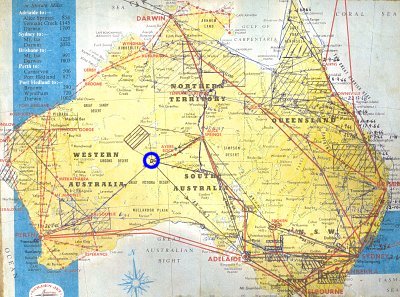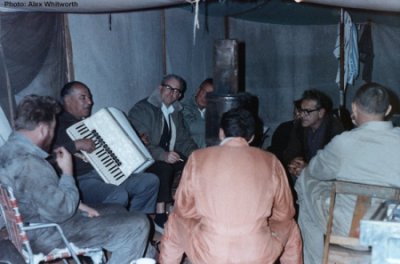|

|
This
dice shaker was made at Giles Weather Station on the edge
of the Gibson Desert in Central Australia in 1968.
Giles is located at 24 37.00 S 126 18.52 E in Google Earth.
|

|
This
map records the author's travels with Adastra.
Giles Weather Station is circled in blue.
|
The dice go back even further than the shaker but my memory, sadly,
does not. I think they came with me from England in 1966 which
would mean that they bounced around at least on the Wardroom bar
in HMS Centaur but I cannot be certain of this.
The shaker was made by Andy Ralla (who was Spanish and insisted
on the correct pronunciation - It's Rallyar Alex, Rallyyaaar!!)
Andy was the maintenance engineer at Giles and he turned the shaker
on the big lathe they had in the workshop. He used an old and
seasoned piece of Mulga wood and it has never cracked despite
the many changes of atmospheric conditions it has been through.
Andy was a lovely guy - tough and independent and a great story
teller. He also played the accordion. The photo below shows him
in our tent in the campsite at Giles on a bitterly cold desert
night with our makeshift stove glowing red hot.

Poker dice is similar to the game that is played with cards. The
dice are shaken in the open and the goal is to build the best
combination with up to 3 throws. The first throw includes all
5 dice but for the second or third, the player is permitted to
select which or all of the 5 dice to throw. Calculating the odds
is a lot simpler than with a pack of 52 cards and the owner of
the lowest combination would buy the drinks.
There is a variant called Liar Dice which is the version we played
and much more fun. The first player throws all 5 dice but so that
the other players can't see the dice. S/he then covers the dice
with the shaker and makes a call, truthful or otherwise and slides
the shaker along the bar to the next player who can then accept
the call or lift the shaker. If the call is accepted, the accepting
player looks at the dice but keeps them hidden and may then throw
any selected number of dice, again hidden from the other players,
but must make a higher call to the next player and so on until
someone lifts the shaker . If the shaker is lifted and the exposed
combination is lower than the call, the caller loses and buys
the drinks. If it is equal or better, the lifter loses. There
are lots of opportunities for ganging up on the inexperienced
and for subtle calls and deception but turning the dice with the
finger is cheating.
Mike Wood and I thought we were the Adastra champions whenever
we happened to be in a bar together and playing with others. Playing
against each other required exquisite levels of deviousness and
facial control. I can still hear Mike's disgusted roar when -
very occasionally - he lost.
The shaker and its dice were very busy in Adastra days but they
then sat on a shelf at home while I was at University and until
I bought my boat, Berrimlla in 1993. They have sailed with
us ever since, so they have done a lot of Sydney - Hobart and
Lord Howe Island races and have been round the world twice, via
both Cape Horn and the Northwest Passage. There were also a couple
of Fastnet races in England. You can see the wear on the rim -
an indicator perhaps of distance travelled along the bars of the
world.
Alex
Whitworth
May 2012
|
![]()